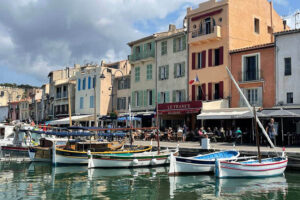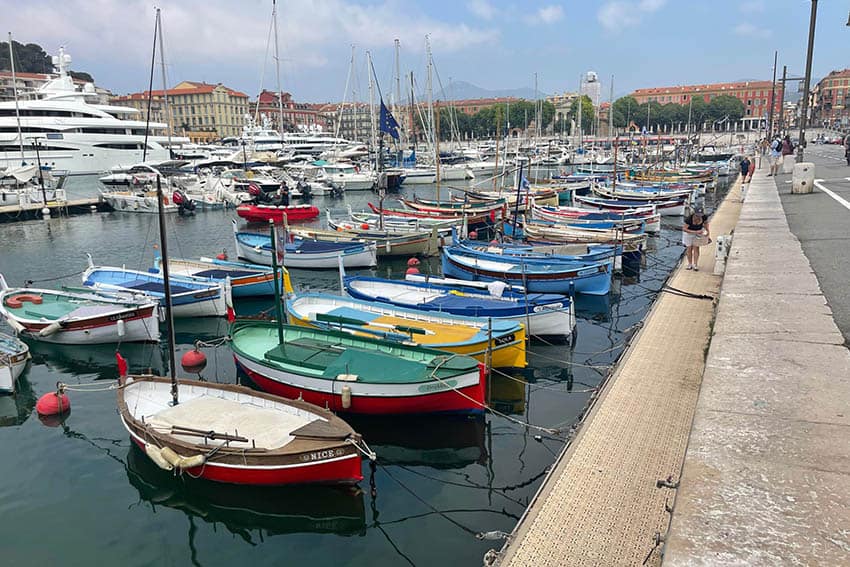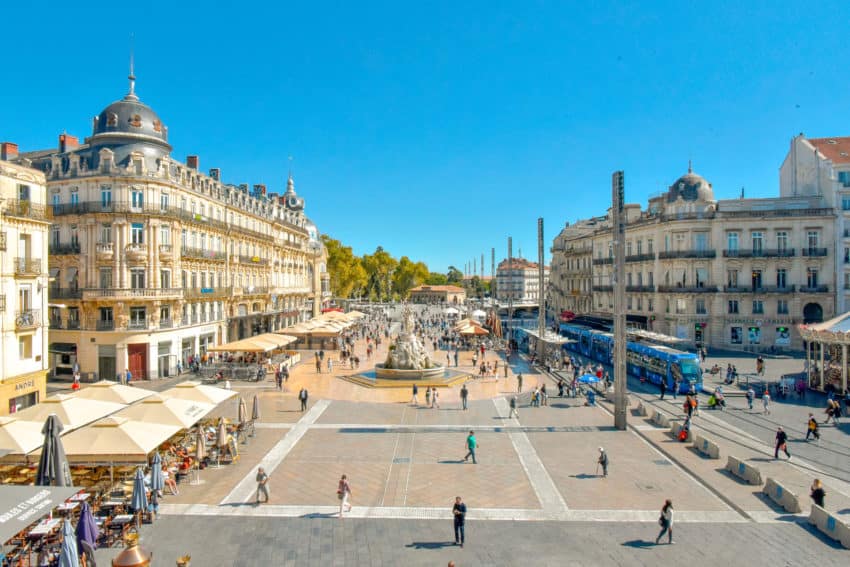
From Montpellier to Minervois: Touring France’s Languedoc-Roussillon Region
By Ginger Warder
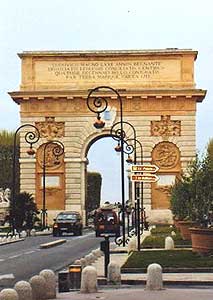
In just one short week of touring the Languedoc-Roussillon Region in the South of France, I met a count, two famous artists, three black labs, two corgis, and one of the top sommeliers in Europe.
I had oysters and beer at a gas station, tasted the best olives in the world, drank more wine in seven days than I usually drink in a month, and had a lesson in the proper techniques of wine tasting.
I sampled the cuisine of Michelin-ranked chefs but had my favorite meal from hotel room service. I also learned some unwritten rules about proper French food etiquette, and the huge signs everywhere that said “To Le Cave” (to the wine cellar) kept making me think of Batman’s famous command, “To the Bat Cave, Robin!”
The Old Walled City
Just an hour’s flight from Paris or a scenic three-and-a-half-hour ride on the 200-mile-per-hour TGV lies the charming city of Montpellier. Energized by the thousands of university students that fill the pedestrian-friendly old walled city, Montpellier is filled with buildings from the 17th, 18th, and 19th centuries, complete with its own Arc de Triomphe on Avenue Foch, and many of the same boutiques and signature couture names found in Paris.
Hôtel le Guilhem lies in the heart of the old town on a narrow little street called rue Jean-Jacques Rousseau that is just steps from the Arc, the Botanical Gardens, and the shopping district.

The large suites feature period furniture, lots of French windows opening onto stunning city views, both a sitting and dining area, and pristine modern bathrooms. Equipped with coffee and tea supplies and an electric kettle, it’s easy to settle in and make yourself at home.
Included in the incredibly reasonable room rates (beginning around 85 Euros) is a huge continental breakfast of flaky croissants and pastries, fresh baguettes with jam and butter, cereals, yogurt, juices, and coffee or tea.
The breakfast room on the second floor opens onto a lovely terrace overlooking the hotel’s charming garden courtyard. It’s a wonderfully peaceful way to begin your day.
The town’s main square, Place de Comédie, has a double-decker carousel that rivals the one in Paris near the Eiffel Tower (2.5 euros for a ticket), a daily outdoor market, a Monoprix department/grocery store, and dozens of café terraces for people watching.
The ornate Opera House and the former headquarters of the region’s wine merchants anchor the square, which this year, will be one of the departure points for the Tour de France. Cyclists will arrive from Marseille and overnight in Montpellier on July 19th, departing from the town square on the morning of the 20th. For more information visit the Montpellier Tourist Office website.
Dogs Are Our Companions
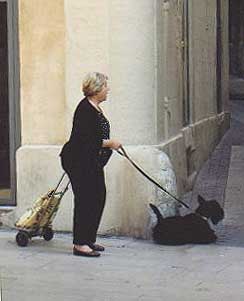
Animal lovers and architecture buffs should make a point of visiting the cathedral of St. Roch. Born in Montpellier in the 14th century, St. Roch is known for protecting the people from the plague. Legend has it that during hard times, a dog saved Roch’s life by foraging for food and delivering bread to him every day in his forest hideout.
All of the local statues, including the one inside the cathedral, show his canine friend by his side. I heartily agree with the French attitude that dogs are our companions: they’re allowed in stores and restaurants, as well as on the trams. I even saw one gentleman pushing a baby stroller with his weeks-old lab puppy inside.
Don’t be alarmed to see a dog running loose on the streets of the city: their owner is sure to be following along behind. Do, however, keep an eye out for doggie droppings as pooper-scooping has not yet caught on in France.
Other “must-sees” in this eminently walkable city include the newly renovated Musée Fabre, one of the foremost museums in Europe. The museum’s collections include both old masters and a new wing that houses the contemporary work of Pierre Soulages, Hantai, Viallat, Bioulès and Dezeuze.
The Montpellier Tourist Office offers a City Card good for one, two, or three days which includes a guided historical tour, transportation pass, and free admission to many cultural attractions. (from 13 Euros to 26 Euros) The colorful city trams, designed by Christian Lacroix, are a perfect way to see the city from end to end.

A Country Idyll in Minervois: Fine Wine and Fresh Oysters
Heading south from Montpellier brings you into the heart of the Languedoc-Rousillon wine and farming region, filled with brilliant fields of yellow mustard punctuated by flaming red poppies, nestled companionably beside vineyards and olive groves.
The old and new exist side-by-side here with crumbling ruins of fortified towers and modern wind farms crowning the hilltops.
Minervois is known not only for its wines, but also for its olives. Visit the complimentary olive oil tasting bar at L’Oulibo, a cooperative retail outlet for local growers which carries all manner of products made from olives and olive wood, from oils, olives, and soap to wooden kitchen utensils and Provencal pottery.
My favorite green orbs were the crunchy, bright green Lucques olives which tasted like they had just been picked from the tree.
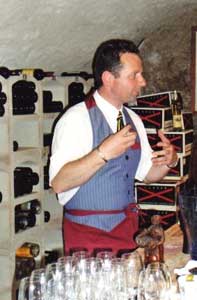
Live like a local and visit the gas station-cum-café located directly in front of L’Oulibo. We joined the happy hour patrons for some freshly shucked oysters and a cold brew, a real moment of everyday French joie de vivre in the countryside.
Swish and Spit
Later that evening, we experienced the opposite side of the coin in beverages as were treated to a wine tasting lesson by François Surget of La Bastide Cabezac. Surget, a finalist in the 2003 Sommelier of Europe Competition, has very definite ideas about the proper way to taste wine. We learned what I have named the Five S’s of wine tasting — swirl, sniff, slant, swish, and spit.
First, holding the glass by the bottom, swirl your wine around to release its aroma and take a deep sniff of the wine’s bouquet. Then, slant your glass and hold it up to the light to check the color and see if it has “legs” (how fast it runs down the side of the glass). Next, take a sip and swish the wine around in your mouth. Finally, spit it out into the waste bowl. Surget says one should never swallow wine during a tasting and never eat food with the wine.
Chateau D’Agel
One of our most magical moments in Minervois was a visit to Chateau d’Agel. If you’ve ever dreamed of living in the French countryside, this is your opportunity to experience it firsthand at the Ecal family home.

Portions of the chateau date back to the 12th century, including a secret tunnel for escaping during sieges, but current owner Martine Ecal-Besse has ingeniously updated the property with modern amenities including modern ensuite bathrooms and Wi-Fi while keeping her family’s period furniture and personal mementos for guests to enjoy.
You can peruse family diaries and photos in the library, or curl up with a good book on the sunny terrace overlooking the chateau’s vineyards.
Working tirelessly on the renovations for the past two years, Martine is now ready to welcome guests and envisions a contemplative artists’ retreat where visitors can settle in for a week or more and make Chateau d’Agel their own home away from home.
French Food-I-Tude
The French take their food seriously, and on this trip, I sampled the cuisine of the hottest new restaurant in Montpellier, Duo, whose owner worked for culinary legend Alain Ducasse in Paris.
Even Air France takes food seriously, with a business class menu that includes duck foie gras terrine, pan-seared lamb noisette, a cheese course, and dessert course, accompanied of course, by appropriate aperitifs and wines.
I, however, am no gourmand. I prefer to see my lambs, ducks, geese, rabbits, and deer in their natural habitats rather than on my plate and am averse to eating any animal’s internal organs. To me, the best food in France is the “workingman’s food” found in neighborhood bistros, tiny brasseries, cafes, and even at hotels.

The French are, hands down, the absolute masters of bread and pastry, so breakfast is my favorite meal of the day: flaky croissants, fresh baguettes with butter and jam, tiny pinwheel pastries with golden raisins, fresh fruit, and even fresher yogurt.
Steaming crocks of homemade soup, perfect omelets with ham and cheese (jambon et Fromage), fresh salads with tasty vinaigrette, and cheese straight from the cow, goat or sheep… gooey ham and cheese sandwiches called Croque Monsieurs… these are the foods that I love to eat in France.
That’s why my favorite meal of the week was my room service order at the Mercure Centre Hotel…a crock of asparagus soup, a fluffy cheese omelet with a side salad garnished with pinenuts, and crusty bread with creamery butter. There’s no reason for even the pickiest eater to ever go hungry in this country.
My brief sojourn in the south of France was a mere “amuse-bouche” of the delights this region has to offer, but if you would like to learn more about the fabulous finds and rich history of Languedoc-Roussillon, look for GoNomad’s upcoming video feature by filmmaker Sony.

10 TRAVEL TIPS: KNOW BEFORE YOU GO
1. You can no longer exchange U.S. currency at French banks without 48-hour advance notice. Bring your debit card to get the best exchange rate or order Euros before leaving home. Visa, Mastercard, and American Express are accepted at most major retail outlets, but bring Euros for smaller shops and outdoor markets.
2. Keep a firm grip on your bag or purse in crowded markets, metro stations, and queues. Pickpockets abound in these situations.
3. Allow at least a two-hour layover in Charles de Gaulle airport in Paris for connecting flights and arrive three hours early for departures. Expect long security lines and you’ll have to remove your cameras, cell phones, and ALL electronic devices for screening.
4. You must validate your Rail Europe at a train station in person and provide your passport and must make a reservation for most trains. There is an additional 3 Euro fee.
5. Upon entering the train station, you must stamp your ticket in one of the yellow machines placed around the lobby area, before heading to the track for boarding.
6. First-class train cars have power outlets at the individual banquette seats, perfect for working while you ride. Observe the happy and sleepy cell phone signs for places on the train where you’re allowed to use your phone.
7. Going through tunnels on the high-speed TGV will make your ears pop, so bring along some chewing gum.
8. If you need extra batteries, postage stamps, etc. visit a local Tabac.
9. While many of the French are bilingual today, learn a few phrases before you go, especially please and thank you.
10. Slow down, especially in mid-day. Most shops close for two to three hours to allow their employees to have a relaxing lunch. When in France….
Eurail Passes: What to Know about Buying a Europe Train Pass
- Back to the Future in Knoxville, Tennessee - December 14, 2023
- Santee Cooper Country, South Carolina for Fishing and Fun - March 31, 2022
- Connemara, Ireland’s West Coast - April 10, 2020


